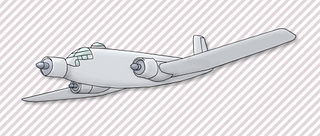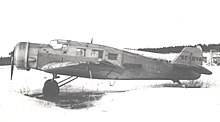
The Focke-Wulf Fw 200 Condor, also known as Kurier to the Allies, is a German all-metal four-engined monoplane originally developed by Focke-Wulf as a long-range airliner. A Japanese request for a long-range maritime patrol aircraft led to military versions that saw service with the Luftwaffe as long-range reconnaissance and anti-shipping/maritime patrol bomber aircraft. The Luftwaffe also made extensive use of the Fw 200 as a transport aircraft.

The Junkers Ju 388Störtebeker is a World War II German Luftwaffe multi-role aircraft based on the Ju 88 airframe by way of the Ju 188. It differed from its predecessors in being intended for high altitude operation, with design features such as a pressurized cockpit for its crew. The Ju 388 was introduced very late in the war, and production problems along with the deteriorating war conditions meant that few were built.

The Junkers Ju 52/3m is a transport aircraft that was designed and manufactured by German aviation company Junkers. First introduced during 1930 as a civilian airliner, it was adapted into a military transport aircraft by Germany's Nazi regime, who exercised power over the company, for its war efforts over the objections of the company's founder Hugo Junkers.

The Heinkel He 70 Blitz ("lightning") was a German mail plane and fast passenger monoplane aircraft of the 1930s designed by Heinkel Flugzeugwerke, which was later used as a bomber and for aerial reconnaissance. It had a brief commercial career before it was replaced by larger types. The He 70 had set eight world speed records by the beginning of 1933.

The Henschel Hs 123 was a single-seat biplane dive bomber and close-support aircraft flown by the German Luftwaffe during the Spanish Civil War and the early to middle of World War II. It proved to be robust, durable and effective especially in severe conditions. It continued to see front-line service until 1944, only to be withdrawn due to a lack of serviceable airframes and spare parts.

The Dornier Do J Wal ("whale") is a twin-engine German flying boat of the 1920s designed by Dornier Flugzeugwerke. The Do J was designated the Do 16 by the Reich Air Ministry (RLM) under its aircraft designation system of 1933.

The Junkers F 13 is the world's first all-metal transport aircraft, developed in Germany at the end of World War I. It was a cantilever-wing monoplane, with enclosed accommodation for four passengers and a two seat open cockpit. 322 examples were manufactured, an exceptionally large number for a commercial airliner of the era, and were operated all over the world. It accounted for over a third of air traffic in the early 1920s. It remained in production for thirteen years and in commercial service for more than thirty. There were many versions including floatplanes for water landing, skis, mailplane, and different engines. Several survive in various states of repair in museums, and a replica of the type was put back in production in the 2010s, taking flight once again nearly a century after the type first flew.

The Junkers Ju 90 was a 40-seat, four-engine airliner developed for and used by Deutsche Luft Hansa shortly before World War II. It was based on the rejected Ju 89 bomber. During the war, the Luftwaffe pressed them into service as military transports.

The Junkers Ju 290 was a large German, four-engine long-range transport, heavy bomber and maritime patrol aircraft used by the Luftwaffe late in World War II. It was developed from an airliner.

The Junkers Ju 86 was a German monoplane bomber and civilian airliner designed in the early 1930s, and employed by various air forces on both sides during World War II. The civilian model Ju 86B could carry ten passengers. Two were delivered to Swissair and five to Deutsche Luft Hansa. In addition a single civilian Ju 86Z was delivered to Sweden's AB Aerotransport.
The Junkers Ju 187 was a German projected dive bomber designed to replace the ageing Junkers Ju 87 Stuka. The Ju 187 was cancelled in 1943.

The BMW 132 was a nine-cylinder radial aircraft engine produced by BMW starting in 1933.

The Junkers Ju 352 Herkules was a German World War II transport aircraft that was developed from the Junkers Ju 252.

The Junkers Ju 252 was a German cargo aircraft that made its first flight in late October 1941. The aircraft was planned as a replacement for the Junkers Ju 52/3m in commercial airline service, but only a small number were built as cargo aircraft for the Luftwaffe.

The Heinkel He 50 was a German World War II-era dive bomber, originally designed for the Imperial Japanese Navy. Serving in Luftwaffe prewar dive-bombing units, the He 50 served until almost the end of World War II as a night harassment bomber.

The Junkers G 24 was a German three-engine, all-metal low-wing monoplane passenger aircraft manufactured by Junkers from 1925. Junkers F 24 was the designation for single-engine versions of the same aircraft.

The Junkers W 33 was a German 1920s single-engine low-wing monoplane transport aircraft that followed Junkers standard practice making extensive use of corrugated aluminium alloy over an aluminium alloy tube frame, that was developed from the similar but slightly smaller Junkers F 13, and evolved into the similar W 34. One example, named Bremen, was the first aircraft to complete the much more difficult east–west non-stop heavier-than-air crossing of the Atlantic.

The Junkers Ju 46 was a German shipborne catapult-launched seaplane derivative of the W 34, constructed for pre-war Luft Hansa's mail service over the Atlantic Ocean. The first production models were delivered in 1932 and replaced the Heinkel He 58, which, along with the He 12, had pioneered these ship-to-shore mail delivery flights.

The Junkers Ju 160 was a German single-engine, low-wing six-seat passenger transport aircraft developed from the Ju 60 and targeted at the same fast airliner market as the Heinkel He 70 and the Lockheed Model 9 Orion. The Deutsche Lufthansa fleet of 21 aircraft began operations in 1935 and continued until the start of World War II.

The Junkers G 31 was an advanced tri-motor airliner produced in small numbers in Germany in the 1920s. Like other Junkers types, it was an all-metal, low-wing cantilever monoplane. In the mid-1920s, the all-metal construction and an aerodynamically 'clean' configuration were remarkable.

























